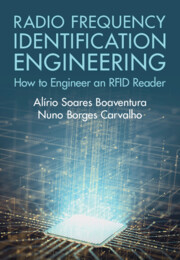Refine search
Actions for selected content:
1562 results in RF and microwave engineering
9 - Wake-Up Radios for IoT Applications
-
- Book:
- Radio Frequency Identification Engineering
- Published online:
- 02 January 2025
- Print publication:
- 09 January 2025, pp 198-211
-
- Chapter
- Export citation
11 - A Battery-less Backscatter Remote Control System
-
- Book:
- Radio Frequency Identification Engineering
- Published online:
- 02 January 2025
- Print publication:
- 09 January 2025, pp 232-250
-
- Chapter
- Export citation
Acknowledgments
-
- Book:
- Radio Frequency Identification Engineering
- Published online:
- 02 January 2025
- Print publication:
- 09 January 2025, pp xii-xii
-
- Chapter
- Export citation
Index
-
- Book:
- Radio Frequency Identification Engineering
- Published online:
- 02 January 2025
- Print publication:
- 09 January 2025, pp 251-252
-
- Chapter
- Export citation
2 - An Introduction to Radio Frequency Identification
-
- Book:
- Radio Frequency Identification Engineering
- Published online:
- 02 January 2025
- Print publication:
- 09 January 2025, pp 14-41
-
- Chapter
- Export citation
6 - A Simple Low-Cost RFID Reader Implementation
-
- Book:
- Radio Frequency Identification Engineering
- Published online:
- 02 January 2025
- Print publication:
- 09 January 2025, pp 131-147
-
- Chapter
- Export citation
Contents
-
- Book:
- Radio Frequency Identification Engineering
- Published online:
- 02 January 2025
- Print publication:
- 09 January 2025, pp vii-ix
-
- Chapter
- Export citation
3 - Backscatter Communications: Fundamentals and Recent Advances
-
- Book:
- Radio Frequency Identification Engineering
- Published online:
- 02 January 2025
- Print publication:
- 09 January 2025, pp 42-76
-
- Chapter
- Export citation
Reviews
-
- Book:
- Radio Frequency Identification Engineering
- Published online:
- 02 January 2025
- Print publication:
- 09 January 2025, pp ii-ii
-
- Chapter
- Export citation
1 - Introduction
-
- Book:
- Radio Frequency Identification Engineering
- Published online:
- 02 January 2025
- Print publication:
- 09 January 2025, pp 1-13
-
- Chapter
- Export citation
Copyright page
-
- Book:
- Radio Frequency Identification Engineering
- Published online:
- 02 January 2025
- Print publication:
- 09 January 2025, pp iv-iv
-
- Chapter
- Export citation

Radio Frequency Identification Engineering
- How to Engineer an RFID Reader
-
- Published online:
- 02 January 2025
- Print publication:
- 09 January 2025
Chapter 11 - Antennas
-
- Book:
- Electromagnetic Fields for Engineers
- Published online:
- 09 January 2025
- Print publication:
- 26 September 2024, pp 553-582
-
- Chapter
- Export citation
Appendix D - Gradient, Divergence, and Curl
-
- Book:
- Electromagnetic Fields for Engineers
- Published online:
- 09 January 2025
- Print publication:
- 26 September 2024, pp 618-635
-
- Chapter
- Export citation
SI Units
-
- Book:
- Electromagnetic Fields for Engineers
- Published online:
- 09 January 2025
- Print publication:
- 26 September 2024, pp xxi-xxiii
-
- Chapter
- Export citation
Appendix C - Scalar and Vector Integration
-
- Book:
- Electromagnetic Fields for Engineers
- Published online:
- 09 January 2025
- Print publication:
- 26 September 2024, pp 604-617
-
- Chapter
- Export citation
Appendix K - Fundamental Constants and Physical Quantities
-
- Book:
- Electromagnetic Fields for Engineers
- Published online:
- 09 January 2025
- Print publication:
- 26 September 2024, pp 663-663
-
- Chapter
- Export citation
Chapter 12 - Wrap Up
-
- Book:
- Electromagnetic Fields for Engineers
- Published online:
- 09 January 2025
- Print publication:
- 26 September 2024, pp 583-583
-
- Chapter
- Export citation
Chapter 5 - Faraday’s Law
-
- Book:
- Electromagnetic Fields for Engineers
- Published online:
- 09 January 2025
- Print publication:
- 26 September 2024, pp 228-254
-
- Chapter
- Export citation
Chapter 8 - Propagation of Waves
-
- Book:
- Electromagnetic Fields for Engineers
- Published online:
- 09 January 2025
- Print publication:
- 26 September 2024, pp 309-414
-
- Chapter
- Export citation
